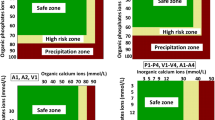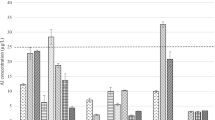Abstract
Purpose
The addition of high amounts of calcium remains a pharmaceutical concern due to its precipitation with phosphate in total parenteral nutrient (TPN) admixtures, compromising also the stability of the lipid emulsion.
Materials and Methods
Calcium-phosphate solubility was compared when using binary PN solutions versus all-in-one TPN (admixtures with lipid emulsions) in three formulas using organic calcium gluconate and gulcose-1-phosphate.
Results
It was found that variation of Ca–P solubility exists between formulation with or without lipid emulsions. Concentrations of Ca decreased after filtrations of all admixtures (from 5% to 30%) and it was more significant in binary solutions. Precipitation has been observed by microscopy at high concentrations of both organic Ca–P after critical conditions of storage (24 h at 37°C plus one day at ambient temperature) for admixtures containing 1% amino acids and 8% glucose with or without lipids compared to admixtures containing 2% or 3.5% amino acids and 14% glucose.
Conclusions
These data demonstrated that availability of Ca using organic glucose-1-phosphate increased when lipids were present in TPN admixtures, without alteration of the lipid emulsion. Thus, high amounts of Ca (up to 30 mmol/l) and phosphates (up to 40 mmol/l) might be provided safely in parenteral nutrition admixtures.



Similar content being viewed by others
Abbreviations
- CaGlu:
-
calcium gluconate
- G1P:
-
glucose-1-phosphate
- IV:
-
intravenous
- IVLEs:
-
intravenous lipid emulsions
- PN:
-
parenteral nutrition
- TPN:
-
total parenteral nutrition
References
P. W. Niemiec, and T. W. Vanderveen. Compatibility considerations in parenteral nutrient solutions. Am. J. Hosp. Pharm. 41:893–911 (1984).
M. I. Barnett, A. G. Cosslett, J. R. Duffield, D. A. Evans, S. B. Hall, and D. R. Williams. Parenteral Nutrition: Pharmaceutical problems of compatibility and stability. Drug Safety. 5(1):101–106 (1990).
D. F. Driscoll, D. W. Newton, and B. R. Bistrian. Precipitation of calcium phosphate from parenteral nutrient fluids. Am. J. Hosp. Phar. 51:28–34 (1994).
M. C. Allwood, and M. C. J. Kearney. Compatibility and stability of additives in parenteral nutrition admixtures. Nutrition. 14(9):697–706 (1998).
J. B. Knowles, G. Cusson, M. Smith, and M. D. Sitrin. Pulmonary deposition of calcium phosphate crystals as a complication of home parenteral nutrition. JPEN. J. Parenter. Enteral Nutr. 13:209 (1989).
S. E. Hill, L. S. Heldman, E. D. H. Goo, and P. E. Whippo. Fatal microvascular pulmonary emboli from precipitation of total nutrient admixture solution. JPEN. J. Parenter. Enteral Nutr. 20:81–88 (1996).
Food and Drug Administration. Safety alert: hazards of precipitation associated with parenteral nutrition. Am. J. Hosp. Pharm. 51:1427–1428 (1994).
K. A. Fitzgerald, and M. W. MacKay. Calcium and phosphate solubility in neonatal parenteral nutrient solutions containing Aminosyn-PF. Am. J. Hosp. Pharm. 44:1396–1400 (1987).
P. Raupp, R. V. Kries, H. G. Pfahl, and F. Manz. Glycero- vs glucose phosphate in parenteral nutrition of premature infants: a comparative in vitro evaluation of calcium phosphorus compatibility. JPEN. J. Parenter. Enteral Nutr. 15:469–473 (1991).
E. Levadoux, V. Sautou-Miranda, A. Arvouet, S. Corny-Peccoux, and J. Chopineau. Stabilité des mélanges binaires de nutrition parentérale pédiatriques, contenant calcium et phosphates. J. Pharm. Clin. 15:28–33 (1996).
L. Periera-da-Silva, A. V. Nurmamodo, J. M. Amaral, M. L. Rosa, M. C. Almeida, and M. L. Ribeiro. Compatibility of calcium and phosphate in four P.N. solutions for preterm neonates. Am. J. Health-Syst. Pharm. 60:1041–1044 (2003).
L. A. Robinson, and B. T. Wright. Central venous catheter occlusion caused by body-heat-mediated calcium phosphate precipitation. Am. J. Hosp. Pharm. 39:120–121 (1982).
B. Dunham, S. Marcuard, P. G. Khazanie, G. Meade, T. Craft, and K. Nichols. The solubility of calcium and phosphorus in neonatal total parenteral nutrition solutions. JPEN. J. Parenter. Enteral Nutr. 15:608–611 (1991).
D. S. Chaieb, J. C. Chaumeil, S. Jebnoun, N. Khrouf, A. Hedhili, and S. Sfar. Calcium and phosphate compatibility and stability studies in different neonatal parenteral nutrition mixtures. EJHP-S. 12:35–40 (2006)Full text at: www.ejhp.org.
M. Prinzivalli, and S. Ceccarelli. Sodium d-fructose-1,6-diphosphate vs. Sodium mono-hydrogen phosphate in total parenteral nutrition: a comparative in vitro assessment of calcium phosphate compatibility. J. Parenter. Enter. Nutr. 23(6):326–332 (1999).
W. Hicks, and G. Hardy. Fructose-1,6-diphosphate can improve long term stability of home parenteral nutrition (HPV) admixtures. Rivista Italiana di-Nutrizione ed Enterale. 19:144–151 (2001).
J. J. Maswoswe, A. U. Okpara, and M. A. Hilliard. An old nemesis: Calcium and phosphate interaction in TPN admixtures. Hosp. Pharm. 30(7):579–586 (1995).
D. F. Driscoll, J. Nehne, H. Peterss, K. Klutsch, B. R. Bistrian, and W. Niemann. Physicochemical stability of intravenous lipid emulsions as all-in-one admixtures intended for the very young. Clin. Nutr. 22(5):489–495 (2003).
J. C. Chaumeil, and D. Brossard. Stabilité des émulsions lipidiques utilisées en nutrition parentérale. Nutr. Clin. Metab. 7:55–64 (1993).
C. Washington, J. A. Ferguson, and S. E. Irwin. Computational prediction of the stability of lipid emulsions in total nutrient admixtures. J. Pharm. Sci. 82:808–812 (1993).
C. Washington. Stability of lipid emulsions for drug delivery. Adv. Drug Delivery Rev. 20:131–145 (1996).
O. Corriol, S. Crauste-Manciet, P. Arnaud, F. Brion, D. Brossard, R. Causse, J. C. Chaumeil, R. Collomp, L. Cynober, J. C. Darbord, Q. Launet, M. Deprez, C. Gard, A. Lagarde, J. Mazère, P. Meunier, D. Davas, S. Neuville, N. Préaux, S. Provost, P. Rambourg, J. L. Saubion, and Y. T. Yona. Recommandantion pour la preparation des mélanges de nutrition parentérale. Nutr. Clin. Met. 19:30–55 (2005).
C. L. Ronchera-OMS, N. V. Jimenez, and J. Peidro. Stability of parenteral nutrition admixtures containing organic phosphates. Clin. Nutr. 14:373–380 (1995).
K. Bethune, M. Allwood, C. Grainger, and C. Wormleighton. Use of filters during the preparation and administration of parenteral nutrition. Nutrition. 17(5):403–408 (2001).
P. A. Ball, K. M. Bethune, J. C. Fox, R. Ledger, and M. I. Barnett. Particulate contamination in parenteral nutrition solutions, still cause of concern. Nutrition. 17:926–929 (2001).
F. S. Bettner, and D. J. Stennett. Effects of pH, temperature, concentration and time on particle counts in lipid-containing total parenteral nutrition admixtures. JPEN. J. Parenter. Enteral Nutr. 10:375–380 (1986).
V. A. Parry, K. R. Harrie, and N. L. MCIntosh-Lowe. Effect of various nutrient ratios on the emulsion stability of total nutrient admixtures. Am. J. Hosp. Pharm. 43:3017–3022 (1986).
C. Gellis, A. Arvouet, V. Sautou-Miranda, A. Exbrayat, V. Tramier, S. Corny-Peccoux, and J. Chopineau. Etude préliminaire de hautes concentrations calciques et phosphatées en mélanges ternaires pédiatriques de nutrition parentérale. Nutr. Clin. Metabol. 14:34–46 (2000).
F. Mangin, D. Brossard, and J. C. Chaumeil. Influence de la concentration en phospholipides d’une émulsion sur la stabilité en mélanges nutritifs complets parentéraux. Journées Corps Gras, réunion commune SNDLF et SFNEP, Tours (1992).
M. Rubin, R. Bilik, A. Aserin, Y. Ziv, Y. Sinai, and M. Dintsman. Catheter obstruction: Analysis of filter content of total nutrient admixture. JPEN. J. Parenter. Enteral Nutr. 6:641–643 (1989).
R. Brown, R. Quercia, and R. Signan. Total nutrient admixtures: a review. JPEN. J. Parenter. Enteral Nutr. 10:650–657 (1986).
C. Washington, A. Athersuch, and D. J. Kynoch. The electrokinetic properties of phospholipid-stabilized fat emulsions. IV- The effect of glucose and pH. Int. J. Pharm. 54:191–197 (1990).
J. C. Chaumeil, F. Devaux, P. Cornette, and D. Brossard. Stabilité et instabilité des mélanges complets pour nutrition parentérale. 5th International Conference on Pharmaceutical Technology, Chateney Malabry, APGI, vol. II, pp 428–434 (1989).
P. A. Ball. Methods of assessing stability of parenteral nutrition regimens. Curr. Opin. Clin. Nutr. Metab. Care. 4:345–349 (2001).
Acknowledgements
We acknowledge the technical assistance of the medical staff of the neonatology department of the Maternity Centre of Tunis. We are also grateful to Dr Gharbi N. (Laboraoire d’analyses à l’Institut de Neurologie Tunis), to Dr Boubaker A. (immunology department of Pasteur Institute—Tunis), to Touati R. in the Emergency and Anti poison Centre (CAMU)—Tunis, to the OPALIA pharmaceutical laboratory, and.to Pr Zouari B. (Faculté de Médecine de Tunis).
Author information
Authors and Affiliations
Corresponding author
Rights and permissions
About this article
Cite this article
Chaieb D., S., Chaumeil, J.C., Jebnoun, S. et al. Effect of the Intravenous Lipid Emulsions on the Availability of Calcium when using Organic Phosphate in TPN Admixtures. Pharm Res 25, 2545–2554 (2008). https://doi.org/10.1007/s11095-008-9671-7
Received:
Accepted:
Published:
Issue Date:
DOI: https://doi.org/10.1007/s11095-008-9671-7




